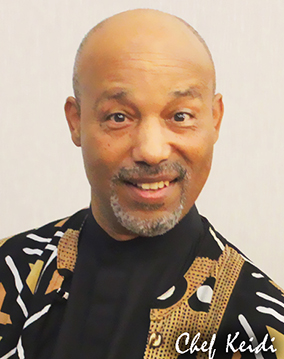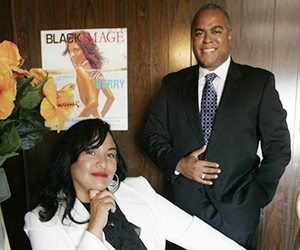QUESTIONS & ANSWERS | KEIDI OBI AWADU
January 21, 2021 by agutting@reviewjournal.com
Filed under Black to Life, Highlights
‘If we don’t change or transform, our fate as Black people is sealed’
Keidi Obi Awadu has authored his 38th book, “Fade to Black: The Passing of a Great Race.” Awadu describes himself as a “scientific futurist of African heritage in the world today. My focus is to manage nation building because Africans need to advance highly-functioning capabilities in various logic-based means of forecasting the future. Scientific futurism includes the disciplines of demographics, science, technology trends, economic patterns, geology, planetary resources, sociology, culture, politics, environment, climate change, humanities, alternative futures analysis, health, biology, as well as trends in education. Scientific futurism requires the intellectual organizing of data patterns across these spectrums of disciplines toward the aim of creating processes for successfully traversing the future.”
Las Vegas Black Image Magazine sat down with Awadu to delve deeper into his book and philosophy.
What makes you such a scholar of African-American demographics?
This has been a lifelong pursuit. I am the son of a chemist — in a highly scientific household. I never went to college, but I ended up working in a scientific laboratory. Within a year of graduating high school, I spent four years there. When most people went on to college for four years, I was already working the field. I publish my … research findings and that is what makes me an expert. I spent a lot of time in renowned research libraries around the country before the internet came out. Now I am able to visit major research libraries around the world on my laptop.
How are you defining demographics?
Demographics is the study of numbers of people and it defines a group’s existence in history that comes together as a large group — then we say we have a “demographic understanding.” The demographic includes the growth and the decline of people within its natural fertility rate. Things such as health — the ability to feed and educate the group. Demographics are important because they are an indicator of a group’s short-term or long-term life.
 What inspired you to write “Fade to Black”?
What inspired you to write “Fade to Black”?
“Fade to Black” is really the accumulation of all the other books I have written. In fact, in Chapter 2, I have a description of every book I have published. “Fade to Black” ultimately was not an easy or a pleasant book to write. I have been issuing warnings to people of African heritage in America and around the world over the course of years, because many of the behaviors that we have acted out are hurting us as Black people.
What is the overall message that your book delivers?
Beginning around 1990 I really started to focus on the science of population and population control and growth. Also, the attributes that give a population its dynamic. And as early as 1992 I started writing papers giving warnings that African-Americans were not paying attention to our demographics, our fertility dynamics and to our overall population. Rule number-one on this planet is, “survival of the fetus.” While we perceive ourselves to be as fit as other people within this society or around the world — our behaviors and outcomes from those behaviors must also reflect this fitness. Unfortunately, my book, “Fade to Black,” has some of the worst things to report on African-American people, such as the epidemic rise in childhood diseases — how obesity has overcome our people and impacting our children. We are talking about a pandemic of non-communal diseases that include: high blood pressure, diabetes, and cancers. We add these all together and weigh them against the very steep decline in our fertility since the 1960s and the outcome, to sum it all up in a sentence: African-Americans have up to 45 years left in existence.
Is the economic instability also sending African-Americans on a decline?
Yes! There was a 1944 book that came out called, “An American Dilemma: The Negro Problem and Modern Democracy,” written by a Swedish Nobel Peace Prize winning economist, Gunnar Myrdal. The study for the book was paid for by Andrew Carnegie. The study was done as the United States was just going into World War II. The question arose within the National Security establishment: “Are there any disgruntled groups inside of America that might serve and align themselves with external enemies?” This was a very serious question that the United States had to answer to at the time of global World War. The same question had been asked during World War I. During that time they said there were five enemies — one of which was Black protest — which was very heightened in the beginning of the 20th Century. In Myrdal’s book on page 167 he indicates, “If we forget about the means for a moment and consider the quantitative goal — the overwhelming majority of white Americans desire that there be as few as possible of African-Americans in America. If the Negro could be eliminated from America in increased numbers, this would meet white approval.” Three pages later — “We see the quantitative goal. Let us talk about the means to do so.”
The best news I have to report is that Black economic stability is happening outside America. The best news I have to report is that we are African people on this planet while the American middle class is shrinking. In fact, during this COVID virus year the really rich of one percent are making money at the fastest rate ever. When Amazon CEO Jeff Bezos can make $13 billion in one day — while 30 million Americans are out of jobs, businesses are closing up and going bankrupt, households are going bankrupt — we are going to have to realize that something is terribly amiss. And if we don’t change or transform, our fate as Black people is sealed.
One year ago during December and November, before COVID, African-Americans for 61 days — above our normal spending patterns throughout the year — spent an additional $1.1 billion a day for 61 days for holiday shopping. That equates to $62.7 billion. That type of investment is equivalent to [what] China invested in the African continent, 54 countries at that time. China received a 5 to 1 return on their investment in international trade. We have to ask the question, “What did we get for spending $62.7 billion of our money which was much needed for the United States’ consumer infrastructure?”
For example, what we didn’t get was grocery store chains. You know there are 211 full service supermarket chains (a chain is ownership of 3 stores or more) in the nation. When I wrote another book of mine called “The Repairing,” in 2016 — Hispanics owned 23 grocery store chains in the United States and African-Americans owned 1 in Alabama. Six months after this book came out the Alabama grocery store chain closed down, so there are zero African-American owned grocery stores in the United States. The Hispanic owned grocery store chains have grown from 23 in 2016 to 37 chains in the United States to date. When we talk about Black economics in the United States, we have to ask ourselves, “Do we have a plan?”






